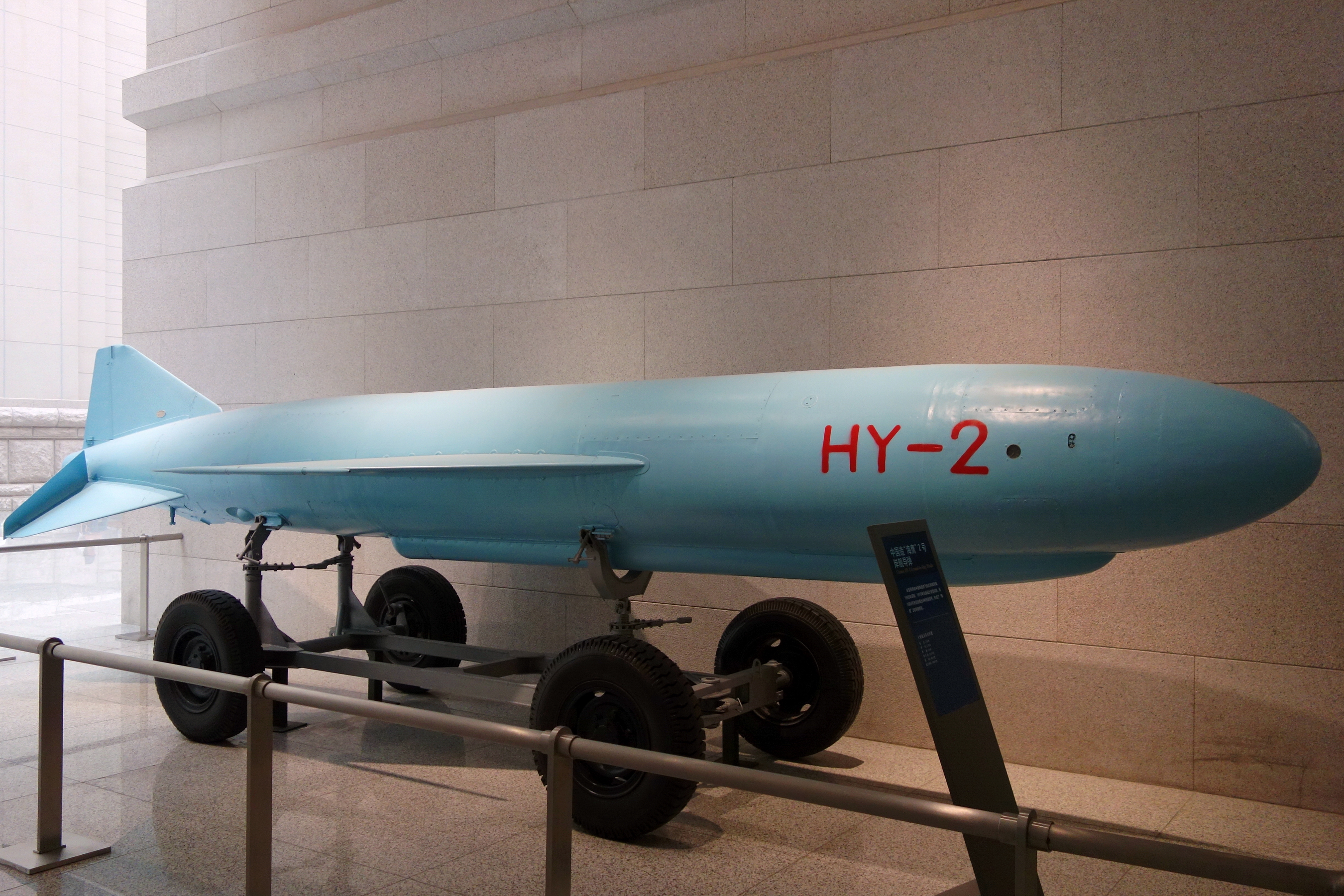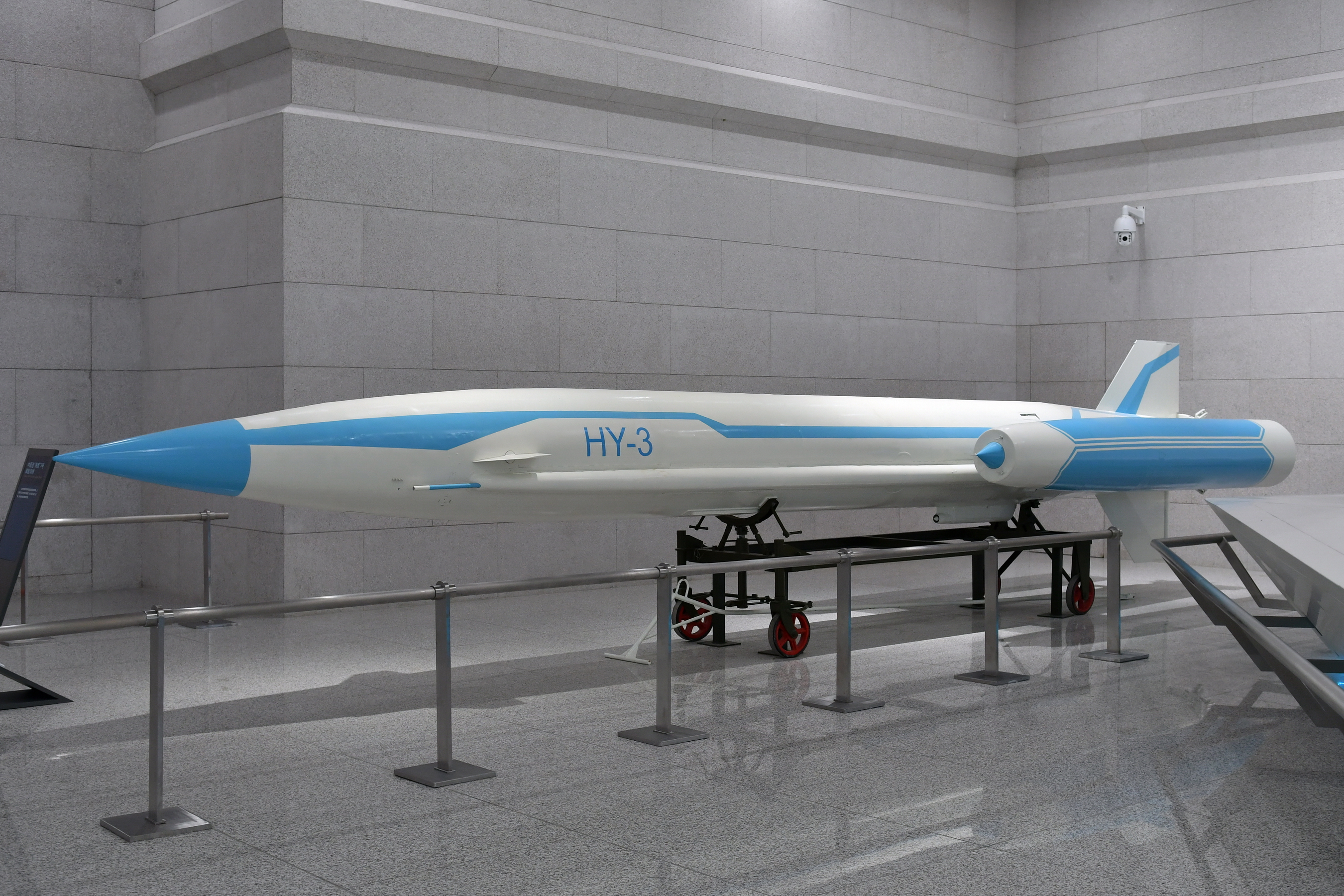C-601 on:
[Wikipedia]
[Google]
[Amazon]
The SY (), and HY () series were early anti-ship cruise missiles (ASCM) developed by the

 Chinese preparations were underway before receiving the first P-15s and related technical data from the Soviets in 1959. On 8 October 1956, the Fifth Academy was founded - with Qian Xuesen as director - to pursue missile development. In March 1958 a cruise missile test site was selected at Liaoxi in
Chinese preparations were underway before receiving the first P-15s and related technical data from the Soviets in 1959. On 8 October 1956, the Fifth Academy was founded - with Qian Xuesen as director - to pursue missile development. In March 1958 a cruise missile test site was selected at Liaoxi in
. June 23, 1997.
Federation of American Scientists page on HY-1
{{DPRK missiles Anti-ship cruise missiles of the People's Republic of China China–Soviet Union relations Guided missiles of the People's Republic of China Surface-to-surface missiles of China
People's Republic of China
China, officially the People's Republic of China (PRC), is a country in East Asia. With population of China, a population exceeding 1.4 billion, it is the list of countries by population (United Nations), second-most populous country after ...
from the Soviet
The Union of Soviet Socialist Republics. (USSR), commonly known as the Soviet Union, was a List of former transcontinental countries#Since 1700, transcontinental country that spanned much of Eurasia from 1922 until Dissolution of the Soviet ...
P-15 Termit missile. They entered service in the late 1960s and remained the main ASCMs deployed by the People's Liberation Army Navy
The People's Liberation Army Navy, also known as the People's Navy, PLA Navy or simply Chinese Navy, is the naval warfare military branch, branch of the People's Liberation Army, the national military of the People's Republic of China. It i ...
through the 1980s. The missiles were used by the PRC and export customers to develop land-attack missiles.
The name Silkworm is popularly used for the entire SY and HY family. As a NATO reporting name
NATO uses a system of code names, called reporting names, to denote military aircraft and other equipment used by post-Soviet states, former Warsaw Pact countries, China, and other countries. The system assists military communications by providi ...
, it applies only to the land-based variant of the HY-1.
Development

 Chinese preparations were underway before receiving the first P-15s and related technical data from the Soviets in 1959. On 8 October 1956, the Fifth Academy was founded - with Qian Xuesen as director - to pursue missile development. In March 1958 a cruise missile test site was selected at Liaoxi in
Chinese preparations were underway before receiving the first P-15s and related technical data from the Soviets in 1959. On 8 October 1956, the Fifth Academy was founded - with Qian Xuesen as director - to pursue missile development. In March 1958 a cruise missile test site was selected at Liaoxi in Liaoning
)
, image_skyline =
, image_alt =
, image_caption = Clockwise: Mukden Palace in Shenyang, Xinghai Square in Dalian, Dalian coast, Yalu River at Dandong
, image_map = Liaoning in China (+all claims hatched).svg
, ...
.
In November 1960, the first successful missile test was conducted after the withdrawal of Soviet advisors in September, due to the Sino-Soviet split
The Sino-Soviet split was the gradual worsening of relations between the People's Republic of China (PRC) and the Union of Soviet Socialist Republics (USSR) during the Cold War. This was primarily caused by divergences that arose from their ...
. The P-15 was copied to become the SY-1. In October 1963, production started at the Nanchang Aircraft Manufacturing Company. In 1965, the first successful test occurred. In August 1967, production was approved. The SY-1 entered service by the end of the decade.
The SY-1 was developed into the improved HY-1. In December 1968, the HY-1 was successfully tested, and entered service in 1974.
Operational history
Iran–Iraq War
The Silkworm gained fame in the 1980s when it was used by both sides in theIran–Iraq War
The Iran–Iraq War, also known as the First Gulf War, was an armed conflict between Iran and Iraq that lasted from September 1980 to August 1988. Active hostilities began with the Iraqi invasion of Iran and lasted for nearly eight years, unti ...
. Both countries were supplied by China. In 1987, Iran launched a number of Silkworm missiles from the Faw Peninsula, striking the American-owned, Liberia
Liberia, officially the Republic of Liberia, is a country on the West African coast. It is bordered by Sierra Leone to Liberia–Sierra Leone border, its northwest, Guinea to Guinea–Liberia border, its north, Ivory Coast to Ivory Coast–Lib ...
n-flagged tanker ''Sungari'' and the U.S.-flagged tanker ''Sea Isle City'' in October 1987. Five other missiles struck areas in Kuwait earlier in the year.
In October 1987, Kuwait's Sea Island offshore oil terminal
An oil terminal (also called a tank farm, tankfarm, oil installation or oil depot) is an industrial facility for the storage of oil, petroleum and petrochemical products, and from which these Petroleum product, products are transported to end u ...
was hit by an Iranian Silkworm, which was observed to have originated from the Faw peninsula. The attack prompted Kuwait to deploy a Hawk missile battery on Failaka Island to protect the terminal. In December 1987, another Iranian Silkworm was fired at the terminal, but it struck a decoy barge instead.
Prior to these attacks the missile's range was thought to be less than , but these attacks proved that the range exceeded with Kuwaiti military observers seeing that the missiles originated from the area and tracking them on radar along with US satellite imagery of the launch sites.Counter-memorial and Counter-claim submitted by the United States of America. June 23, 1997.
Persian Gulf War
On February 25, 1991 during Operation Desert Storm, a shore-based Iraqi launcher fired two Silkworm missiles at the USS ''Missouri'' which was in company with the USS ''Jarrett'' and HMS ''Gloucester''. A Sea Dart missile from HMS ''Gloucester'' shot down one Silkworm and the other missed, crashing into the ocean.Royal Air Force
The Royal Air Force (RAF) is the Air force, air and space force of the United Kingdom, British Overseas Territories and Crown Dependencies. It was formed towards the end of the World War I, First World War on 1 April 1918, on the merger of t ...
officers subsequently recovered an HY-2 missile at Umm Qasr in southern Iraq. It is currently displayed at the Royal Air Force Museum Midlands.
Iraq War
During the 2003 invasion of Iraq,Iraq
Iraq, officially the Republic of Iraq, is a country in West Asia. It is bordered by Saudi Arabia to Iraq–Saudi Arabia border, the south, Turkey to Iraq–Turkey border, the north, Iran to Iran–Iraq border, the east, the Persian Gulf and ...
used the Silkworm (HY-2 Seersucker) as a surface to surface missile, by firing at least two of them at the coalition positions in Kuwait
Kuwait, officially the State of Kuwait, is a country in West Asia and the geopolitical region known as the Middle East. It is situated in the northern edge of the Arabian Peninsula at the head of the Persian Gulf, bordering Iraq to Iraq–Kuwait ...
.
Blockade of Yemen
On 12 October 2016, during the Blockade of Yemen, two Silkworm missiles were fired from the Houthi-controlled port ofAl Hudaydah
Hodeidah (), also transliterated as Hodeda, Hodeida, Hudaida or al-Hudaydah, is the fourth-largest city in Yemen and its Hudaydah Port, principal port on the Red Sea and it is the centre of Al Hudaydah Governorate. As of 2023, it had an estimate ...
at the destroyer operating in the Bab el-Mandeb strait. Both impacted the sea, possibly due to the countermeasures.
Variants
SY series
;SY-1 :License produced version of the P-15 Termit. NATO reporting name CSS-N-1 Scrubbrush. ;SY-2 :NATO reporting names CSS-N-5 Sabot. The SY-2 is a significant redesign of the SY-1 missile and is no longer a copy of the P-15. The missile has a longer airframe and is powered by a solid propellant rocket motor, instead of the liquid propellant design from the Styx. The SY-2 otherwise shares launchers and support equipment with the SY-1 (P-15), however, and eventually replaced the old missiles on unmodernized Jianghu class frigates. ;SY-2A :An improved SY-2 with a longer range. ;FL-2 :The export version of the SY-2.HY series
;HY-1 :NATO reporting names CSS-N-2 Safflower (ship-based) and CSSC-2 Silkworm (land-based.) ;HY-2 :NATO reporting names CSS-N-3 Seersucker (ship-based) and CSSC-3 Seersucker (land-based.) ;HY-3 :Unsuccessful supersonic variant. ;HY-4 :Powered by a WP-11turbojet
The turbojet is an airbreathing jet engine which is typically used in aircraft. It consists of a gas turbine with a propelling nozzle. The gas turbine has an air inlet which includes inlet guide vanes, a compressor, a combustion chamber, and ...
, a reverse-engineered Teledyne-Ryan J69-T-41A. Used for LACM development. NATO reporting name Sadsack.
;HY-41
:An improved HY-4.
;C-201
:An export version of the HY-2.
;C-301
:An export version of the HY-3.
;C-201W
:An export version of the HY-4.
;XM-41
:An export version of the HY-41.
Further development
; YJ-6 :Anti-ship missile developed from the HY-2. ;YJ-63 :Air-launched LACM sharing visual characteristics of the HY-2, HY-4, and YJ-6. 200 km range. ;AG-1 :Longer-ranged variant of the HY-2 developed byNorth Korea
North Korea, officially the Democratic People's Republic of Korea (DPRK), is a country in East Asia. It constitutes the northern half of the Korea, Korean Peninsula and borders China and Russia to the north at the Yalu River, Yalu (Amnok) an ...
.
Operators
; * ; * ; * ; *References
Sources
* *External links
Federation of American Scientists page on HY-1
{{DPRK missiles Anti-ship cruise missiles of the People's Republic of China China–Soviet Union relations Guided missiles of the People's Republic of China Surface-to-surface missiles of China